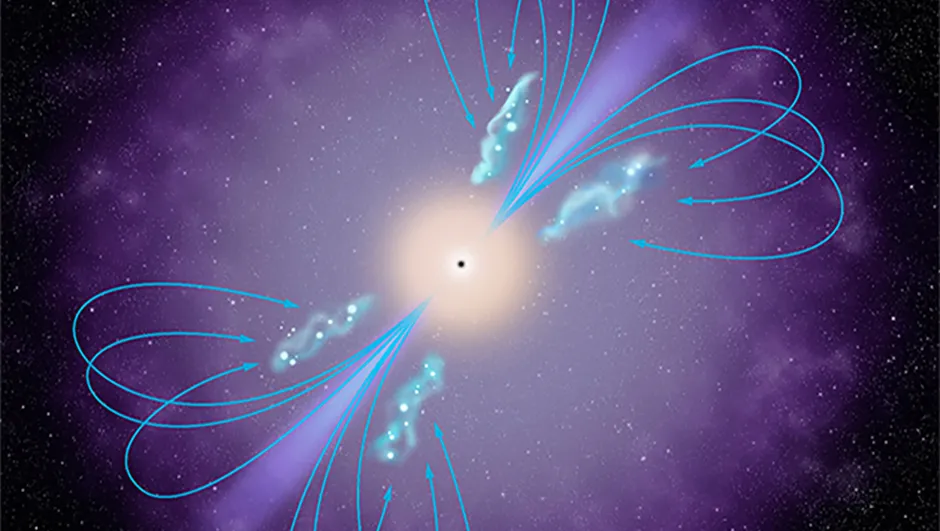xczA sample of galaxies as seen by Hubble showing chains of star formation in ultraviolet light. The star formation is a product of the jets from a central black hole controlling the falling gas from the galaxy's halo. Image Credit: NASA, ESA, G. Tremblay (Yale University), and R. Mittal (Rochester Institute of Technology, and Max Planck Institute for Gravitational Physics)
Data from the Hubble Space Telescope has been used in two studies addressing a long-pondered galactic perplexity: how elliptical galaxies continue forming stars after their activity has peaked.
Hubble has revealed clumps of hot, blue stars forming along the jets of black holes at the centres of these giant ellipticals.
The Hubble data was combined with ground observations to reveal a self-regulating cycle whereby black hole jets heat the surrounding gas, which then cools and forms cold clumps that rain back into the galaxy’s centre.
"The 'raindrops' eventually cool enough to become star-forming clouds of cold molecular gas, and the far-ultraviolet capabilities of Hubble allowed us to directly observe these 'showers' of star formation," says Grant Tremblay of Yale University, who led one of two independent studies examining the process.
"We know that these showers are linked to the jets because they're found in filaments and tendrils that wrap around the jets or hug the edges of giant bubbles that the jets have inflated.
They end up making a swirling 'puddle' of star-forming gas around the central black hole."
The intensity of this ‘raining’ gas returning to the centre is then limited by the black hole.
While the outward-flowing gas cools, the black hole heats the rest of the gas around the galaxy, preventing the gaseous envelope from cooling more quickly.
This process has been likened to the thermostat on a domestic heating and cooling system.
The gas around the black hole fuels its jets and, if too much cooling occurs, the jets become more powerful and add more heat.
If the jets add too much heat, they reduce their fuel supply and eventually weaken.

The study is also helping explain why many elliptical galaxies do not experience a higher rate of star birth.
The first study made into this process was led by Megan Donahue of Michigan State University.
It looked at far-ultraviolet light from massive elliptical galaxies found in the Cluster Lensing And Supernova Survey with Hubble (CLASH).
These included galaxies that are raining and forming stars and others that are not.
The second study, led by Tremblay, looked only at elliptical galaxies in the nearby Universe with fireworks at their centers.
Both studies found that the filaments and knots of star birth seem to be similar phenomena.
The research was aided by new computer simulations of the hydrodynamics of the gas flows developed by Yuan Li of the University of Michigan.
"This is the first time we now have models in hand that predict how these things ought to look," says Donahue.
"And when we compare the models to the data, there's a stunning similarity between the star-forming showers we observe and ones that occur in simulations.
We're getting a physical insight that we can then apply to models."